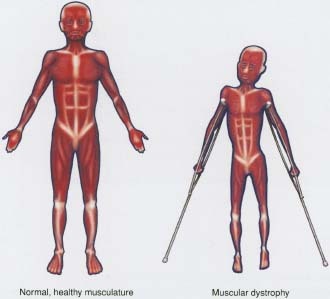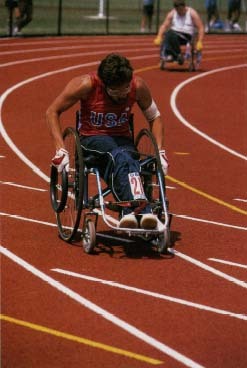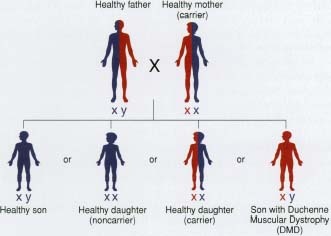Muscular Dystrophy

Muscular dystrophy (DIS-tro-fee) is a group of inherited disorders in which there is a gradual deterioration and weakening of muscles in the body.
KEYWORDS
for searching the Internet and other reference sources
Duchenne
Muscular disorders
Neurology
What Is Muscular Dystrophy?
The term "muscular dystrophy" actually includes a group of disorders that affect different muscles in the body, and that may range from mild to severe. Although all of the muscular dystrophies are known to be caused by genes * , the way in which the genes produce the disorder is as yet only partly understood.
The muscles that become weakened in muscular dystrophy are mostly the voluntary muscles, those that we can control when we want to move different parts of the body. Another name for voluntary muscle is skeletal muscle. The weakness is usually symmetrical; that is, it occurs more or less equally on both sides of the body. Muscle deterioration is also progressive, or gradually increasing over time. There is no pain connected with the weakening condition, although there may be some cramps and stiffness. Mental retardation sometimes accompanies this condition.
* genes are chemicals in the body that help determine a person's characteristics, such as hair or eye color. They are inherited from a person's parents and are contained in the chromosomes found in the cells of the body.
Who Gets Muscular Dystrophy?
All types of muscular dystrophy are uncommon. Still, numbers of individuals affected range in the tens of thousands. Many people have come to know something about muscular dystrophy through the efforts of the famous American comedian and actor Jerry Lewis, who has appeared on television on behalf of the Muscular Dystrophy Association. Similar media appeals, such as the Telethon in France, have raised public awareness about the disease in other countries.
The most common and severe form of the disorder, called Duchenne (du-SHEN) muscular dystrophy, affects about 2 in 1,000 young boys. In the United States, it has been estimated that 40,000 boys and young men are afflicted with this form. In western Europe, an estimated 70,000 are affected. The incidence * is believed to be comparable throughout the world. Muscular dystrophy affects all races, ethnic groups, and social dasses equally.
What Causes Muscular Dystrophy?
Whether or not someone has a form of muscular dystrophy has already been determined through hereditary factors by the time they are born (even though its effects are not apparent at birth). It also means that the disease is not in any way contagious, and that it is not brought on by anything that might happen in one's everyday life.
* Incidence means rate of occurrence.
* chromosome (KRO-mo-som) is a threadlike structure inside cells on which the genes are located. The X chromosome is one of two that determine whether a person is male or female. If you have two X chromosomes, then you are female; if you have one X and one Y chromosome, then you are male.
The defective gene that causes Duchenne muscular dystrophy is located on the X chromosome * . The disorder is therefore said to be sex-linked. It also is recessive, which means that females who inherit the defective gene will not usually develop the disease (because they need to have the defective gene on both X chromosomes) but are carriers of it. They can pass it on to the next generation. Affected males always inherit the gene for Duchenne


Myotonic (mi-o-TON-ik) dystrophy, an adult form of the disorder, is inherited as an autosomal dominant. Autosomal means that the gene that causes the disorder is not located on a sex chromosome. Dominant means that just one defective gene in a pair is able to produce the disease. Males and females are equally affected by the faulty gene, and both can transmit the disease to their children.
Other types of muscular dystrophy follow various different patterns of inheritance, and they can affect both children and adults.
Muscles under a Microscope
The gene responsible for the Duchenne form of muscular dystrophy was discovered in 1986. That was an important breakthrough, but scientists still needed to know how the gene caused muscle weakness. The following year, a protein that was named dystrophin (DIS-tro-fin) was found to be absent in the muscles of Duchenne patients and present in normal tissue. Therefore, the defective Duchenne gene does not produce dystrophin, while the same gene in its normal form does produce this protein. To understand why dystrophin is important in muscle function, a powerful microscope is needed.
Seen under a microscope, muscles are made up of bundles of individual muscle fibers. Under greater magnification, each fiber is seen to have an outer membrane. Dystrophin is believed to be responsible for maintaining the structure of the muscle fiber membrane. Without it, the membrane tends to fall apart and become "leaky." One of the substances that leaks out from inside the muscle fibers is creatine kinase (KREE-a-tin KI-naze), which is needed for the chemical reactions that produce energy for muscle contraction.
In other types of muscular dystrophy, the defect lies in an abnormality in another substance closely associated in function with dystrophin.
What Are the Symptoms of the Dystrophies?
There are several forms of muscular dystrophy. Some experts have listed as many as 20 types. Classification of types is based upon a person's age at the start of the disease, the location of the muscles affected, the rate at which the disorder progresses, and the pattern of inheritance. The following are signs and symptoms of the more common and well-defined forms.
Duchenne Muscular Dystrophy
The signs of Duchenne muscular dystrophy may not be noticed until ages 3 to 7, when the young boy is likely to start having difficulty walking. (Because of the way it is inherited, only boys usually have Duchenne muscular dystrophy.) Another characteristic sign is that the calf muscles, although becoming weaker, are enlarged partly because of accumulating deposits of fat in them.
Muscle weakness steadily advances from the lower to the upper body, and a wheelchair is usually needed by about age 12. Complications such as scoliosis (side-to-side curving of the spine) and lung infections commonly occur in the teen years, and the person may not live past his late teens or early twenties.
Becker Muscular Dystrophy
In this form, the signs and symptoms are the same as those of Duchenne muscular dystrophy, but begin later in life and progress more slowly. The same gene that causes the Duchenne form is responsible, but its defects are less damaging to muscle. Most affected men must eventually use a wheelchair, but some do not, and many live past middle age.
Myotonic Dystrophy
Myotonic dystrophy usually develops in adult-hood, but may occur as early as infancy. Males and females are affected equally. The characteristic symptom is myotonia, a delayed relaxation of muscle after it has contracted. Weakness commonly occurs in the muscles of the hands, face, neck, forearms, and lower legs.
What's in a Name?
The word "dystrophy" comes originally from the Greek "dys," which means "difficult" or "faulty," and "trophe," meaning "nourishment." This word was chosen many years ago because it was at first believed that poor nourishment of the muscles was in some way to blame for muscular dystrophy. Today we know that muscle wasting in the disorder is caused by defective genes rather than poor nutrition.
The "Duchenne" in Duchenne muscular dystrophy may have been a bit of a misnomer as well. The French neurologist Guillaume Benjamin Amand Duchenne (1806-1875) described the disorder in detail in 1868. However, recent research has shown that the English physician Edward Meryon (1809—1880) had independently described the condition several years before Duchenne.
Unlike other dystrophies, myotonic dystrophy may involve parts of the body other than the voluntary muscles. For example, the heart rate may be abnormally slowed. Cataracts may develop in the eyes. As in other dystrophies, mental retardation sometimes accompanies the condition. Nonetheless, people with mild forms of myotonic dystrophy may have relatively normal lives and survive beyond middle age.

Facioscapulohumeral Muscular Dystrophy
Facioscapulohumeral (fay-she-o-skap-yoo-lo-HU-me-ral) muscular dystrophy gets its long name from the fact that it weakens the muscles of the face, shoulders (the scapula is the shoulder blade), and upper arms (the humerus is the upper arm bone). Facial expression is altered, and the shoulders tend to droop. Both males and females are affected, and the progression of symptoms is usually slow. Symptoms most often begin to appear between the ages of 10 and 40.
Limb Girdle Muscular Dystrophy
Muscle weakness in this form occurs mostly around the hips and shoulders (limb girdles). Symptoms may eventually extend to other muscles. Often, however, worsening of the condition is slow. Both sexes are affected, and symptoms may begin in late childhood or early adult life.
How Is Muscular Dystrophy Diagnosed?
A doctor may suspect that someone has muscular dystrophy just by observing certain signs of muscle weakness. If someone in the patient's immediate family is known to have the disorder, the diagnosis becomes clearer.
To confirm the diagnosis, a blood test may be performed to look for high levels of creatine kinase, mentioned earlier as a sign of Duchenne muscular dystrophy. Blood samples may also be analyzed for defective genes, and can help determine the specific type of the disorder. Other tests can measure muscle activity, and a muscle biopsy, in which a tiny sample of muscle tissue is removed to be examined under the micro-scope, can show specific abnormalities.
How Is Muscular Dystrophy Treated?
At present there is no cure for muscular dystrophy. Sometimes treatment with steroids can slow progress of muscular weakness. Treatment is aimed at maintaining general good health and mobility for as long as possible. An important goal is preventing scoliosis and often fatal lung infection. Moderate exercise, physical therapy, the use of braces, and sometimes surgery can assist walking.
Genetic counselors, using medical tests and family history, can help prospective parents make informed decisions about having children. The disease can be diagnosed in a baby before it is born; this is called prenatal testing.
Meanwhile, medical scientists in the laboratory are working on ways to attack the cause of muscular dystrophy directly, through a technique called gene therapy.
See also
Genetic Diseases
Scoliosis
Resources
Emery, Alan E. M. Muscular Dystrophy: The Facts. Oxford: Oxford University Press, 1994. This book provides in nontechnical language much helpful information about the disorder for patients and their caregivers.
Muscular Dystrophy Association provides general information on its
website.
http://www.mdusa.org/
Muscular Dystrophy Association of Canada also provides information on
its website.
http://www.mdac.ca/
The muscular dystrophies (MD) are a group of genetic diseases characterized by progressive weakness and degeneration of the skeletal muscles that control movement. There are many forms of muscular dystrophy, some noticeable at birth (congenital muscular dystrophy), others in adolescence (Becker MD), but the 3 most common types are Duchenne, facioscapulohumeral, and myotonic. These three types differ in terms of pattern of inheritance, age of onset, rate of progression, and distribution of weakness.
Duchenne MD primarily affects boys and is the result of mutations in the gene that regulates dystrophin - a protein involved in maintaining the integrity of muscle fiber. Onset is between 3-5 years and progresses rapidly. Most boys become unable to walk at 12, and by 20 have to use a respirator to breathe.
Facioscapulohumeral MD appears in adolescence and causes progressive weakness in facial muscles and certain muscles in the arms and legs. It progresses slowly and can vary in symptoms from mild to disabling.
Myotonic MD varies in the age of onset and is characterized by myotonia (prolonged muscle spasm) in the fingers and facial muscles; a floppy-footed, high-stepping gait; cataracts; cardiac abnormalities; and endocrine disturbances. Individuals with myotonic MD have long faces and drooping eyelids; men have frontal baldness.
Is there any treatment?
There is no specific treatment for any of the forms of MD. Respiratory therapy, physical therapy to prevent painful muscle contractures, orthopedic appliances used for support, and corrective orthopedic surgery may be needed to improve the quality of life in some cases. Cardiac abnormalities may require a pacemaker. Corticosteroids such as prednisone can slow the rate of muscle deterioration in patients with Duchenne MD but causes side effects. Myotonia is usually treated with medications such as mexiletine, phenytoin, or quinine.
What is the prognosis?
The prognosis of MD varies according to the type of MD and the progression of the disorder. Some cases may be mild and progress very slowly over a normal lifespan, while other cases may have more marked progression of muscle weakness, functional disability, and loss of the ability to walk. In Duchenne MD, death usually occurs in the early 20s.
What research is being done?
The NINDS supports a broad program of research on MD. The goals of these studies are to understand MD and to develop techniques to diagnose, treat, prevent, and ultimately cure muscular dystrophy